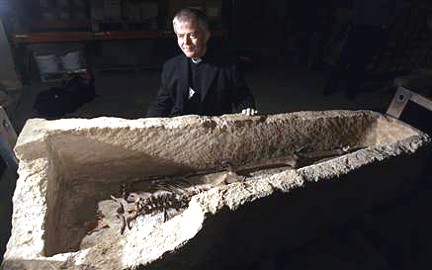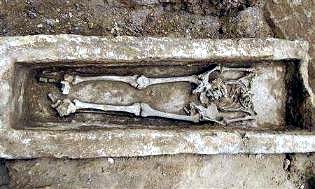El hallazgo de un sarcófago amplía las fronteras de Londres en la época romana
Photo: A Roman limestone sarcophagus containing a headless skeleton is prepared for display at the Museum of London, after being discovered by archaeologists during renovations at St Martin-in-the-Fields Church. The Rev. Nicholas Holtam, the church's vicar, surveys the sarcophagus on Thursday. Alastair Grant / AP
El hallazgo de un sarcófago romano en una conocida iglesia del centro de Londres obligará a redefinir las fronteras de la antigua ciudad de Londinium, que hasta ahora se creía circunscrita a una pequeña área del este de la capital. Los arqueólogos del Museo de Londres se mostraron ayer «entusiasmados» con el sorprendente descubrimiento de una tumba de finales del siglo IV o principios del V en los terrenos del templo anglicano de Saint Martin in the Fields, en la plaza de Trafalgar, considerada un enclave anglosajón.
El sarcófago, de piedra caliza y de 1,5 toneladas de peso, contiene los restos de un hombre de unos 40 años 1,70 metros de altura y sin cráneo, seguramente retirado en el siglo XIX por los obreros que construyeron el alcantarillado. «Que esté tan lejos de lo que hasta ahora se consideraba la ciudad romana nos obliga a replantearnos sus fronteras e incluso el período de la ocupación», afirmó la directora del Servicio Arqueológico del Museo de Londres, Taryn Nixon. «Estamos al principio de una etapa de investigación fascinante», añadió.
Hasta ahora se creía que Londinium, fundada en el año 43 d. de C. por el emperador Claudio, ocupaba lo que actualmente es la City (centro financiero londinense). El hallazgo sugiere que la presencia romana pudo extenderse más al oeste, hasta Westminster.
Fuente: Judith Mora, Londres / La Voz de Galicia, 1 de diciembre de 2006
Enlace: http://www.lavozdegalicia.es/se_
sociedad/noticia.jsp?CAT=105&TEXTO=5333362
(2) Roman Sarcophagus Found at London Site
The find has opened up an exciting new area of Roman London for study Archaeologists discovered a rare Roman limestone sarcophagus containing a headless skeleton at the site of an historic London's church, authorities said Friday.
The find dates to about 410 A.D. and lay 10 feet below the grounds of the St. Martin-in-the-Fields church near central London's busy Trafalgar Square, outside the boundaries researchers had established for London's Roman city walls.
'The find has opened up an exciting new area of Roman London for study,' said Taryn Nixon, director of the Museum of London Archaeology Service.
Excavators and archaeological teams discovered 24 medieval burial sites in the area above and around the Roman sarcophagus during work on the church grounds this summer. The discovery lies in view of the National Gallery art museum and the square, which is often congested with tourists.
The sarcophagus was made from a single piece of limestone from Oxfordshire or Northamptonshire, about 60 miles northwest of London, researchers said. The skeleton, headless and missing fingers, is a 5-foot-6-inch male who died in his 40s. Researchers speculated that Victorian workmen building a sewer stumbled upon the sarcophagus and took the head.
The site is about a mile west of the boundary of Roman London established by researchers, said Roman history expert Hedley Swain.
Archaeologists made two similar finds in London during the 1970s and once at Westminster Abbey during the 19th century.
Fuente: Associated Press. November 30, 2006
Enlace: http://www.topix.net/content/ap/
2124765914038404643219801539433674464591


0 comentarios